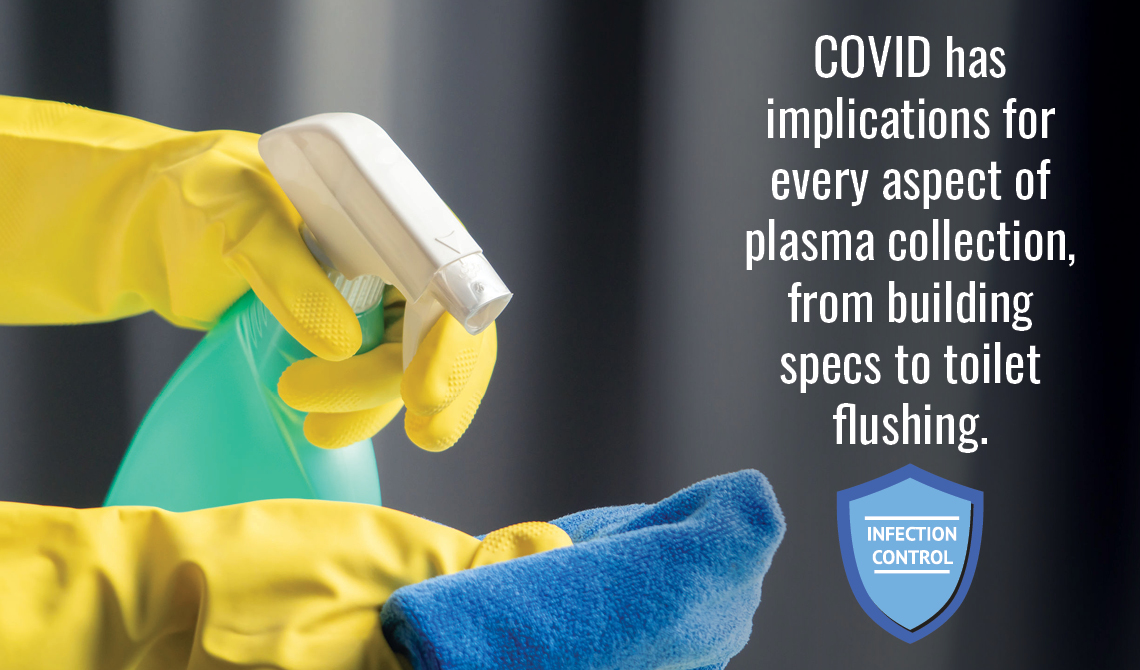
The good news is, there are many inexpensive things you can do to help donors and staff members feel safer in your center, thereby maintaining or even increasing production.
CHANGES TO CONSIDER
We will be glad to discuss any of the suggestions provided below, along with any additional ideas you may have. This is an ongoing process; we are continually evaluating our designs and building, HVAC and surface specs to make plasma centers safer.
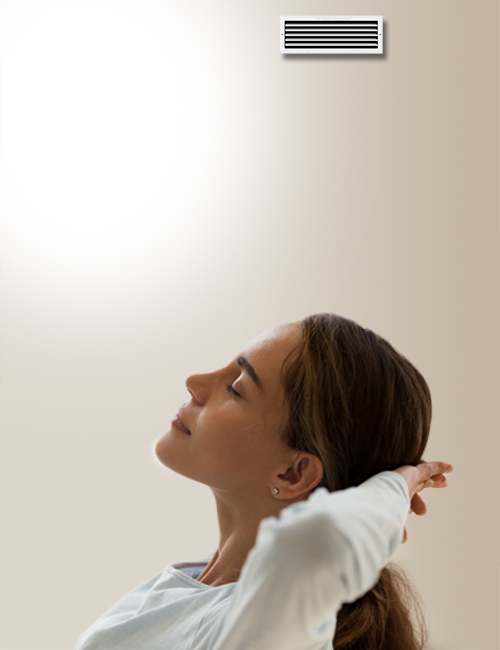
1. Improve production with better ventilation and higher humidity
Negative air pressure, hard-ducted air returns, air returns in every room, supply diffusers on outside walls, and strict high CFM standards can keep virus particles out of your centers.
If you have Stough-build centers, you are already benefitting from all these healthy-building choices. If you don’t, we can help.
Air circulation
We are also currently recommending centers maintain a C02 measurement of 600 ppm or lower to ensure you are circulating air enough to remove COVID aerosols.
To attain a C02 level of 600 ppm, you may need to adjust your mechanical ventilation system to pump in more outside air more often.
You can purchase a C02 monitor for about $100.
Air filtration
We are exploring whether air filters in the ductwork could be a good solution for further keeping indoor air safe. In the meantime, you may want to consider portable air filters.
Humidity
A recent Harvard Medical School study has shown that maintaining a relative humidity of 40-60 percent was associated with lower rates of infection and inflammatory disease. With this level of humidity, infectious aerosols quickly settle out of the air. Inhaled viruses are less infectious in this RH range, and higher humidity also helps the immune system fight infections.
This small change could make a big difference.
Back To Top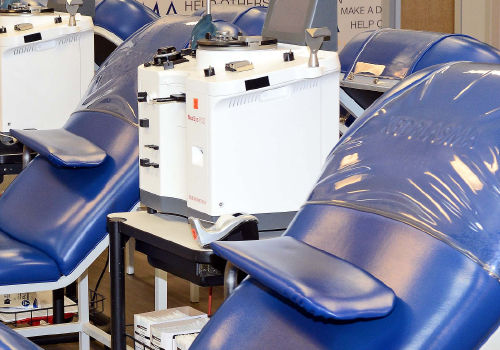
2. When surfaces are easy-clean, they get cleaned more often
Because of COVID, we are currently re-evaluating every surface typically used in a Stough-built center. Surfaces in a plasma center should meet the following criteria:
- Antimicrobial
- Cleanable
- Able to withstand bleach at a 1:10 ratio
- Durable
We addressed cleanable surfaces in a previous blog, The Magic of Cleanable Finishes, written before the onset of COVID-19. Here are some key considerations:
Wallcoverings
Instead of drywall walls, we recommend Type II vinyl wallcoverings (medium to heavy-duty) that are durable and made for high-traffic areas. They should be washable/scrubbable, have a high breaking strength, low crocking (tendency to give off color when rubbed), be stain-resistant, have a high coating adhesion, and high cold crack resistance.
Wallcoverings should also be smooth for cleanability. You don’t want anything with texture that could hold in blood, bacteria and viruses.
Flooring
We use vinyl sheet goods, which have fewer seams for blood, bacteria and viruses to penetrate. This durable type of flooring is also warm and pleasing to look at, which helps improve the overall morale of patients and workers.
In our phlebotomy wards, we use a BioSpec rolled cove base. This is achieved by running the flooring up the wall. It keeps dirt and doesn’t allow liquids or particles to penetrate beneath it, preventing the growth of bacteria.
As with preferred ventilation for stopping COVID, your Stough building already incorporates these preferred options.
Back To Top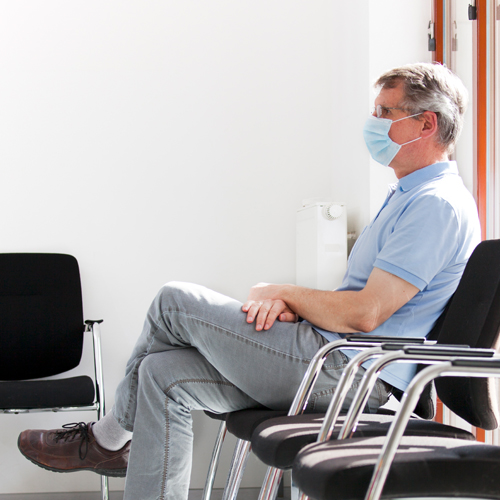
3. Make your waiting rooms welcoming and safe
To prevent the spread of infection in waiting rooms, many plasma centers are having donors wait in their cars for their turn to donate plasma. This practice has several problems:
- Donors who did not bring a cell phone have to loiter near the entry. Not a good look.
- People whose phones are low on power have to keep checking to see if it is time for them to enter. This creates an unnecessary risks.
- Donors do not feel welcome when they cannot come into the building until their time to donate.
Some solutions may include: expanding waiting areas to allow for social distancing, adding partitions or drapes between seats, and offering hands-free hand sanitizing in waiting areas.
Back To Top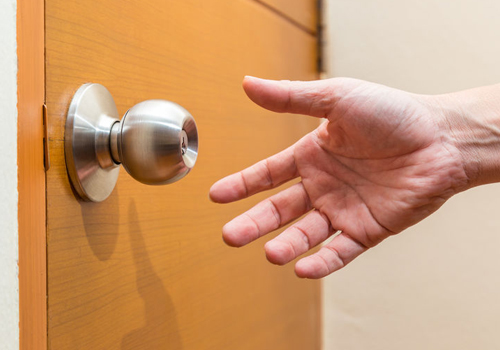
4. Consider no-touch entry
You may want to consider replacing exterior and waiting room doors with automatic doors that do not require touching a handle or doorknob.
While there is a substantial cost involved, this change will reduce the need to constantly clean door handles/knobs.
Back To Top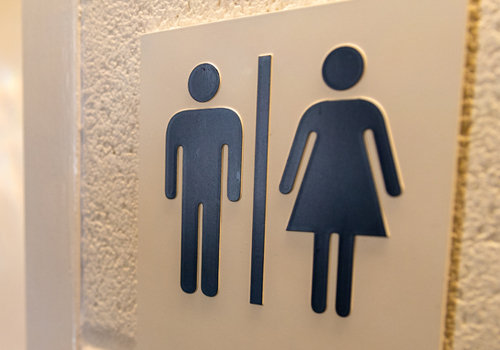
5. Reduce bioaerosols in bathrooms
Recent studies are showing that COVID-19 is likely spread through fecal matter–aerosolized when one flushes the toilet. These “bioaerosols” spread and stay until they settle on surfaces, are removed through ventilation or filtration, or someone breathes them in.
What you can do:
- Make sure your bathrooms have exhaust ventilation. One cubic foot of air should be removed per minute for every square foot in your bathroom. This involves about eight air exchanges per hour. Instruct bathroom users to turn on the exhaust fan when they enter the bathroom and leave it on when they leave.
- If you have no exhaust fan, but have bathrooms windows, keep them cracked a few inches.
- Be sure your sink and toilet U-traps are not dried out. During SARS, investigators found apartments with empty U-trap drains allowed bioaerosols to enter buildings pipes and spread to apartments several floors away.
- Insist on flushing.
- Teach staff and donors to put the lid down after using the toilet. A 2018 study found high concentrations of bioaerosols near toilets with no lids.
- Clean bathroom surfaces often, wearing protective gear that has been safely stored. Destroy gear safely after use.
You may also want to look at hands-free-flush toilets, hands-free faucets, and sheet vs. roll toilet paper (toilet paper is the most contaminated item in the bathroom). Putting partitions between toilets in the men’s room is another idea, along with making stall walls reach farther toward ceiling and floor.
Back To TopMAKING YOUR BUILDING AS SAFE AND WELCOMING AS POSSIBLE CAN INCREASE PRODUCTION AS DONORS COME TO PREFER YOUR CENTER. WE CAN HELP IF YOU WOULD LIKE TO MAKE ANY OF THE RETROFITS MENTIONED ABOVE.
Sources:
LA Times, Commentary: Past pandemics changed the design of cities. Six ways COVID-19 could do the same, by Sam Lubell, 4.22.2020
The National Interest, How Better Ventilation Can Prevent the Spread of Coronavirus Indoors, by Shelly Miller, Professor of Mechanical Engineering, University of Colorado, 8.11.2020
Fox 8 WTVY/WVUE, New Orleans, Good ventilation practices important in COVID fight, 8.10.2020
Pcbtoday, Indoor humidity regulations will reduce burden of COVID-19, 4.14.2020
The Washington Post, It’s time to talk about how toilets may be spreading COVID-19, by Joseph G. Allen, associate professor, director of the Healthy Buildings program at Harvard University’s T.H. Chan School of Public Health, 9.1.2020
Reach Us
To streamline delivery and control costs, we take a prototype approach when possible, engage local civil engineering consultants for each project, and establish a working relationship with the local governing authority.